Lets Talk Jewelry

Information on identification for the collector or lover of antique and vintage jewelry. Posting notes on all kinds of bits of information, tips and identification help.
Why the 'Tooth Test or Grit Test' For Pearls Is False

First, stop...just stop quoting and using the 'tooth / grit / resistance test on pearls as how to identify them. Here's why. The pearls shown are smooth and glassy, they are also waxed and polished so the nacre is no longer gritty but they are a strand of $4,000 Japanese Akoya cultured pearls and not 'fake' as the grit test result indicates.
The often repeated question, "are my pearls real or fake?", is one of the top jewelry questions if not the #1 asked in jewelry forums and pages all over the internet. It is followed up by the #1 response of do the 'tooth test' which is also known as the 'grit test' or 'friction test'. If your not familiar with what that is, then you either don't have pearls or never asked the question of what kind of pearls you have. First before going any further there is a translation between what the public uses for pearl terms and what the jewelry trade uses. To eliminate confusion, the public and sites that want to use terms that the general public will recognize, use the descriptive terms of 'real' and 'fake' for pearls. The jewelry industry goes by 'cultured' or the rarer 'natural' pearls in place of 'real' and 'simulated' or 'imitation' in place of 'fake'. For making this easier to follow I will continue using the general public's use of the terms 'real' and 'fake' even though those are terms I would never use otherwise.
The test is where you either rub two pearls together or rub a pearl on the sharp edge of your tooth. The theory of this test is if you feel a resistance when you rub two pearls together or feel a gritty resistance against your tooth, it means they are 'real' pearls. If the beads glide smoothly against one other or slide over your tooth edge with no gritty resistance, it is supposed to mean they are 'fake' pearls.
Where this test is best used when its done as a secondary test in combination with high magnification and not relied on solely as the only source of identification. The reason this is the most unreliable test to use solely for determining both types of pearls is that the test results are being over simplified on a very complex product. There are many reasons why the results are completely false. Did you know that 'fake' and 'real' pearls can both have coatings and treatments that make the surface test completely the opposite of what they are testing to be? Most people that are familiar with the test have heard that there can be gritty coatings on 'fake' pearls that mimic the grit and resistance giving a false positive test result of 'real' pearls. What is never mentioned and not even widely known unless you deal with pearls in the industry is that for the past 20 to 30 years pearl harvesters have applied treatments to improve surface imperfections and give a higher luster that make lower quality 'real' pearls have a smooth glassy surface by covering over the gritty nacre layer. Doing this artificially improves a cultured pearl's surface imperfections and gives the impression of higher luster and a better quality pearl than it actually is. Another popular treatment is lacquering the surface of a 'real' pearl of lower luster to make it look like it has a higher luster. However the layer is not permanent and can show a peeling of the fine layers over a short period of time. These coating enhancements, both the polished wax layer and the lacquered layer makes the pearl's surface slippery and glassy with no resistance, the coatings cover over the gritty texture and will give a false result on a 'real' pearls being misidentified as 'fake' pearls.
For best identification practices for the most accurate results always do a couple different tests before making the judgment call. Study on learning how to identify pearls from magnification (the higher the better, 50x is recommended) as the first main test being the most important deciding factor...even then, if your not regularly dealing in pearls take them to someone who does for an experienced 2nd opinion, as pearls are among the most difficult items to properly identify even by the professionals. The difference in a wrong ID can be thousands of dollars your loss if you misidentify a strand of Akoya or South Sea cultured pearls as 'fake' because they feel smooth by the tooth test.
Fortunately there will always obvious imitations that you don't even need to test because they are obvious by sight examination alone. The more pearls you handle and examine, the easier it becomes to identify. There are treatments to luster though that are much harder to spot. If the strand is not obvious to being 'fake' pearls then your go to method to test should be high magnification of the recommended 50x over the resistance/glide test which you can now see why it can go so wrong if it's all your relying on. Now happy hunting on finding all those misidentified 'real' pearls that were tagged as 'fake'!
Some links that describe the waxy, polishing and lacquering treatment processes:
https://pearlwise.pro/types-of...
https://www.pearl-guide.com/th...
How to properly test your pearls with pearl industry mention that the much used tooth test is unreliable.
https://www.jewellerybusiness.com/features/detecting-pearl-imitations-and-treatments/
KGC Maker's Mark Trademark
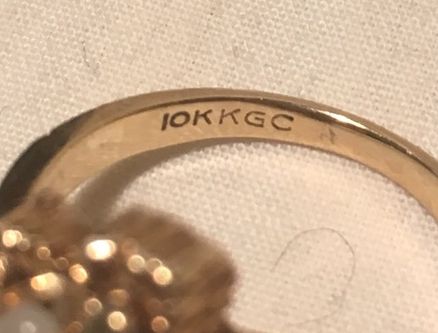
The letter mark KGC is found on many mid 1900's to the 3rd quarter of the 1900's jewelry. They do not appear to be imported goods and there seems to be quite a mystery on who the maker actually is. A number of names are associated with the mark mainly the Kimberly Gem Company in the Jeweler's Building on 47th Ave New York City.
Another name brought up is maker A H Schreiber, Providence Rhode Island, in business 1897 -1910 as they are listed as using the trade name "Kimberly". However we can rule them out automatically as a possibility as there is a large quantity of KGC marked jewelry and A.H. Schreiber was only in business 13 years around the turn of the 20th century and all KGC items are mid century to modern era.
In a 1904 Jeweler's Circular book, "Kimberly Gem" was listed as a subdivision of Albert Lorsch & Co, at 37 Maiden Lane, NYC. It's not listed with the "Co" at the end though. They are noted as manufacturers of jewelry set with imitation and synthetic stones but no mention of the business after 1922 so this option can be excluded too.
The Parker Pen Co also used the brand name Kimberly, along with Towle Silversmith's but neither of the companies entered the trademark Kimberly for use with jewelry.
So from the above information collected on the trademark of KGC which was noted on an online site to be registered in 1951, under the Kimberly Gem Co address at 62 West 47th Street, New York. When you try to verify this information there is no record of any legal filings under this name at all, never mind in 1951. There is no listings in the JCK under Kimberly Gem Co so there is no information to go on of its existence beyond posts mentioning it's name. Did they even exist and where is the documentation to prove that the Kimberly Gem Co used the mark KGC? One post mentioned a finding filed in 1951 with a link that was not active. That was the only hint as to where to find this information. The inactive link showed a trademark registration number that started CA which tells us that it is a Canadian registered mark. With this hint a lookup was done in the Canadian trademark database and there it was located...the verification needed to document the business's name, location and years that is was in business. The KGC letter mark is also used without the background cartouche.
Date of first use in CANADA March 10, 1949
14 - Precious and semi-precious metals, and jewellery
JCR Maker's Mark
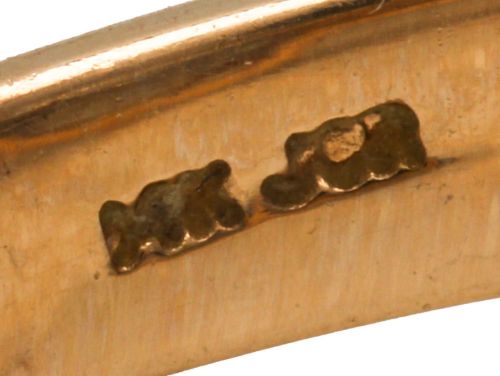
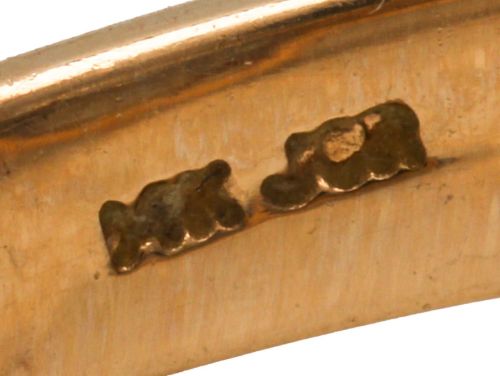
Here I go again...my pet peeve is Google misinformation and everyone just copying one another. Ok make that two pet peeves. When you search for the owner of trademark JCR the seemingly unanimous answer is John C. Rinker. You will find that not only individual sales listings but large platform sites like Etsy, Ebay and EBTH, who touts themselves as the premier platform, all sellers are advertising their jewelry as something it isn't. Their titles state "a rare John C Rinker, or "hand made by John C Rinker and made by "famous designer John C. Rinker". When you google John C. Rinker you come up with a page with his name and his initials JCR and a quick scan shows he was a jewelry designer. You can read about him here http://blog.petersuchyjewelers.com/2013/07/about-john-c-rinker-jcr-jewelry-master-jeweler/. So far so good here's his name, the letters JCR, its mentioned he was a designer and every listing you looked at is selling a JCR item is using his name so there's the maker's match, right? Wrong......What is not clear is that buried in the above linked article that although John spent his career as a designer, he designed under other business' names and not his own. He never featured or marketed his own branded jewelry until he owned the shop John C. Rinker Jewelry in Baltimore MD. The article goes on to explain his business was a repair shop where "patron's brought their jewelry to Rinker for expert repairs. He restores antique pieces made of platinum, gold or silver". He did dabble in bespoke custom designed pieces but "It is interesting to note that while this artisan does not design and create collections of his works, he does feature examples of his work" in his work shop. When a Federal trademark search is conducted under John's name there is no filing for his own mark under his or his business name. So the question still remains, who really does own the JCR trademark?
Here is the federally filed data for the owner, JAM CREATIONS, INC. A mass merchandiser / manufacturer located in New York City's jewelry district that was founded in 1989. https://start.cortera.com/company/research/k3q9pzp8k/jam-creations-inc/ . Jam Creations used the JCR letter mark from April 1996 until June 2004. There is a hand full of sellers who have attributed this mark to "designer Chuck Clemency" of Jam Creations and presented the jewelry as if it was personally made by him.....that would not be correct either. True it is his product as the principal owner but manufactured in a mass production environment and without a doubt never touched by the hands of Chuck Clemency. The merchandise, many of which were sold through mass marketing channels, fall between up scale to mid range for price points.
75047678 - JCR
Status: Dead/Cancelled, Registration cancelled because registrant did not file an acceptable declaration under Section 8
There is also a registration filed in Canada 0377212- JCR that was filed in 1974 and expunged in 2006. The mark was registered by JEAN-CLAUDE RIVET, 6079 Boulevard Monk, Montreal, QUÉBEC and passed onto other Rivet family members. The filing of JAM Creations was attemped in Canada in 1998 but the registration was abandoned as the mark was already in use by Jean-Claude Rivet. However the volume output of jewelry from this maker will be limited as Jean-Claude Rivet, a Montréal watchmaker and owner of a small independant retail jewellery store from 1955 to 1993, with wife Rita Rivet, who was a gemstone importer, were a family business. When considering the jewelry designer turned jewelry repair shop owner John C. Rinker's connection to the JCR mark and the Canadian independant jewellery store who registered the JCR mark from the mid 1900s until 1998, it becomes evident that most all jewelry marked JCR will have been manufactured by mass merchandiser JAM Creations.
Indian Head Henry Wexel & Co or Romega Mark?

Your Misidentified H. Wexel & Co indian head trademark is actually Romega Inc's trademark.
Have you wondered why you come across so many ring's being identified as being made by H.Wexel & Co when they were only in business for 6 years between 1892 - 1898. Maybe you noticed something a bit off when Wexel items are described as antique or Victorian era yet were not even close to being 100 years old? Well thanks to Google everyone who uses it to conduct a search for the Indian head or Chief head trademark will find every single one of Romega Inc's items being misidentified as made by H. Wexel & Co or Henry Wexel. Hopefully this post will clarify and change that!
The only thing in common is both makers use an Indian Chief's head mark. That's where the similarity ends though as the two companies and their marks are completely different from each other and from different centuries. Once you know what the mark for Henry Wexel actually looks like there is no mistaking the real maker. One major difference is all of Romega Inc's jewelry was made in the mid 20th century, from about 1950 to as early as the 1940s possibly but not confirmed with the last entry for them in 1969. Although their jewelry is fairly common to find (of course it's under H. Wexel's name) there is not a lot of information published on Romega Inc to date. Provided below is the information on both company's and their correct trademarks.
From Dorothy T Rainwater's, American Jewelry Manufacturer's: H. Wexel & Co was located in Attleboro, Massachusetts. They had entry listings in the Jeweler's Circular 1896 and 1904 "out of business: Other sources online note them in business from 1892 to 1898. Either way they were only in business a few short years. Actual H. Wexel jewelry is very rare and does not turn up often. There was one ring several years ago I came across being sold online but the image was not saved, however it was a gold and diamond ring. If you see an Indian head it must have the circle around it, like the mark below, in order to be an authentic Henry Wexel item. In addition their jewelry would have been higher end and not sterling and gold filled like Romega's.
Also too add its being passed around on Etsy that rare Henry Wexel's designs were copied by Uncas Manufacturing....how do people come up with this?? No H. Wexell's designs were not copied by Uncas manufacturing. All Uncas's jewelry is 20th century Art Deco to mid 20th century in design where Wexell's was Victorian gold jewelry. Let's put that fire out before everyone thinks this is a fact too. The seller in question giving this information out had no proof nor does she know where she came about this story. So there you go. Here is a link on Wexell & Company's real trademark shown below on this informative site https://www.langantiques.com/university/mark/wexel-co-h/ .


H. Wexel & Co | <----Trademarks ---> | Romega Inc
There is even less information on Romega Inc. Dorothy T Rainwater's American Jewelry Manufacturer's has only one documented listing entry in the Jeweler's Circular from "1950 to present". I don't know when Dorothy researched her information exactly but it appears to be approx the 1970s. In additional to Rainwater's book there were 3 entries for US. Federal Patents with the last being 1969. It can be estimated they were in business until the 1970's. All the jewelry from Romega is commercial base level quality, sterling silver and costume. They are most popular for their pierced sterling silver wide wedding bands, sterling with glass stone Art Deco style rings and gold filled jewelry. If you see items being sold as a "rare Henry Wexel" or "the design is copied from Wexel" what you have is a mid 20th century manufactured item that has no connection to to either the Wexel company or their designs. There are several examples shown below that are glass, crystal, rolled gold plated jewelry and pierced sterling bands. Now you will be aware of what your really purchasing and that it is neither rare or antique. Here is a link to Romega's trademark information https://www.langantiques.com/university/mark/romega-inc/.
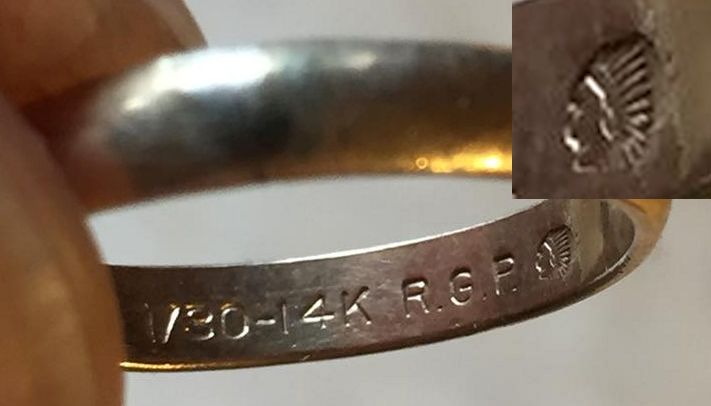
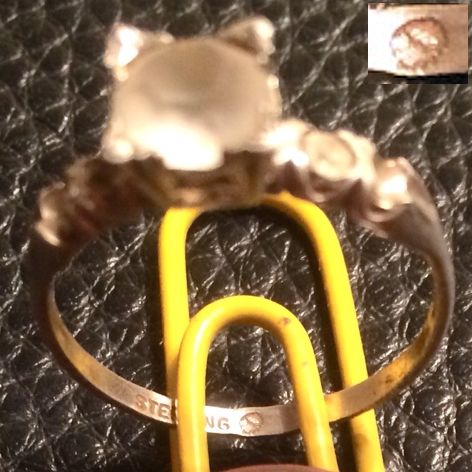

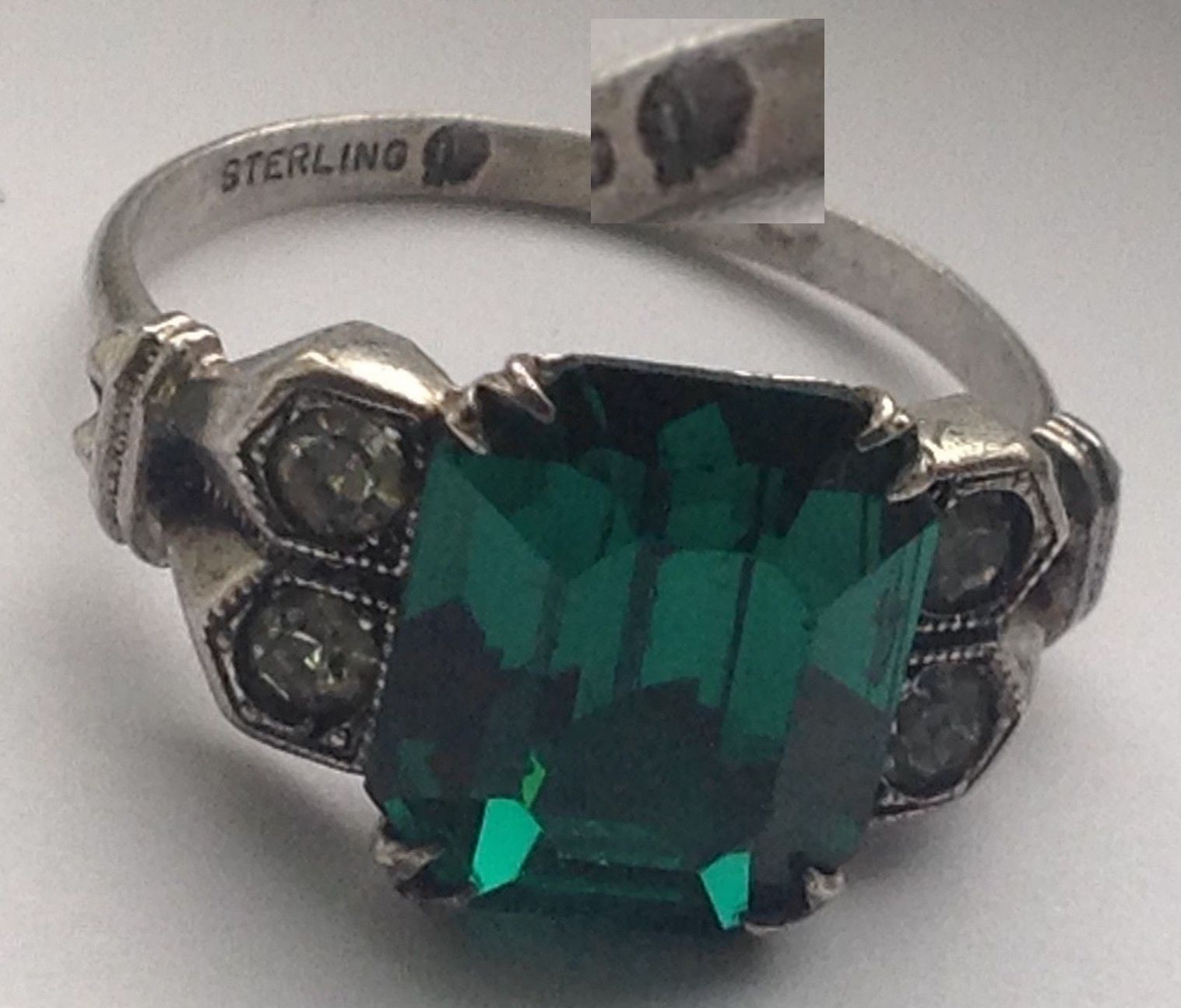
LUC Makers Mark

Makers mark LUC. What do the letters LUC mean when stamped on Jewelry as a trademark? HSN used this mark on jewelry manufactured by Lucoral Company. They also had a line of Lucas LaMeth jewelry manufactured by Lucoral marked LUC. When Googled one will find many LUC marked items are being incorrectly identified and sold as made by designer Lucas MaMeth. He is a jewelry and home accents designer who gave the rights for designs on HSN to be sold under his name but is not the maker. Jewelry marked LUC is not made by Lucas LaMeth nor is it a designer item but a mass produced, mass marketed 'brand' produced by a mass jewelry manufacturer. When an item is marked LUC it does not automatically mean it is a Lucas LaMeth brand piece as this letter mark is used on all other jewelry manufactured for Lucoral Co., Inc. CORPORATION NEW YORK.
· The word mark LUC is registered to Lucoral Co., Inc. CORPORATION in New York with international branches
Word Mark: LUC
Goods and
Services IC 014. US 028. G & S: jewelry. FIRST USE: 19920603. FIRST USE IN
COMMERCE: 1992-06-03
Filing Date June 26, 1992
Owner (REGISTRANT) Lucoral Co., Inc. CORPORATION NEW YORK 10 WEST 46TH STREET,
2ND FLOOR New York NEW YORK 10036 Live/Dead Indicator LIVE
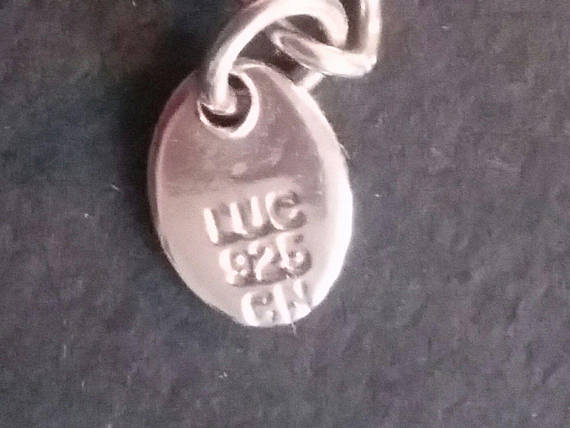
NF Makers Mark

What do the letters NF mean on my jewelry? This is a frequently asked question as there is a huge amount of jewelry with this mark starting from the 1980s. When you see NF stamped on your jewelry it does not mean Nickel Free or Nickel Filled as posted by everyone who is giving out this information as you scroll through the search results. Since sterling silver jewelry does not contain nickel in its alloy there would be no reason to have to identify it as nickel free. The NF mark is not a reference to the alloy contents as it is the registered trademark for the importer. In addition there may be a THAI or THAILAND stamp for the items manufactured in Thailand.
Registration Number 1754499 NF
Date of the registration 23.02.1993
Date of the termination of the registration of the mark (Cancelled) 26.02.2016
Date of filing of the application 27.12.1990
(Owner) CHAPAL-ZENRAY, INC. Corporation TEXAS, 1451 Wycliff, Dallas TX 75207.
(Registrant) CHAPAL-ZENRAY, INC. Corporation TEXAS, 1451 Wycliff, Dallas TX 75207
The reason why such a large quantity of jewelry is seen marked NF is because Chapal-Zenray is a mass merchandiser in business since the 1980’s. https://www.chapal.com/ . “Chapal, Inc. was established in 1980 and is known as one of the leading manufacturers and suppliers of precious metal and gem stone jewelry in the world. Chapal is a strategic partner with many of the mass merchandisers in the U.S. Our services include product design and development, production, inventory management and distribution.”
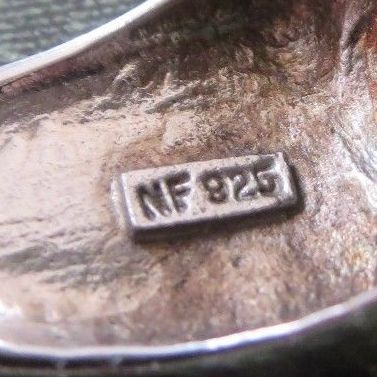
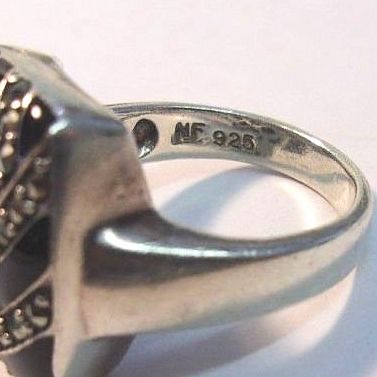
SKAL Makers Mark
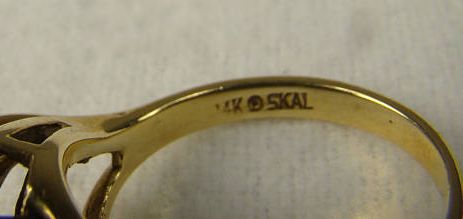
SKAL is not the mark for a Hubertus Von Skal. It is not used by 'designers' Phil or Ira Skalet although Phil Skalet was the president of Skalet Manufactuing Company Inc who is the mass manufacturer. First do a browser search for SKAL, go ahead really do it and see what results you get. Everyone is thinking that they have an item by a Modernist Bohemian designer Hubertus Von Skal because "SKAL 14k" is used in a browser search to see what that means. The search results pull up listings saying their ring is a signed Hubertus Von Skal or an Ira Skalet. Except there is a problem with that, Hubertus is a mid century German designer, which eliminates him from all jewelry marked 14k, 10k, 18k that's American manufactured. The other thing is no one bothered to look into the actual work of Hubertus to see his makers mark or his work (ie. his real work identified by galleries in Germany that hold his pieces) . If they did they would see Hubertus only does one of a kind artist/gallery works of art that are unsigned and in materials that are not common to commercially sold jewelry. This is a case of one person identifying the wrong maker and everyone without fact checking followed the lead.
The other name everyone is attaching to the SKAL mark Phil and Ira Skalet. Phil the owner and Ira the Vice President's names which are being used like they were the 'designer' or maker of the items themselves. When you have a vintage ring marked SKAL...you do not have Phil Skalet or an Ira Skalet designed item. You have a mass produced item that was manufactured in a factory by designers hired by the Skalet's who then sold in department chain stores. The owners who oversaw the business operation did not personally design or make any of their items in production.
SKAL is the registered trademark for Skalet Manufacturing Company Inc and RICHLINE GROUP, INC. The SKAL mark originated from the Skalet Manufacturing Company Inc of New York. All jewelry marked SKAL is manufactured by Skalet Manufacturing or later the Richline Group, Inc., whom is the USA’s foremost, Jewelry Manufacturer, Distributor and Marketer for HSN and QVC. Both companies were mass merchandiser's. Depending on when the item was made the SKAL mark was first used in 1940. It was registered in 1956 with the letters at a diagonal angle for Skalet Manufacturing Company Inc. By the late 1970s Skalet was acquired by the the Richline Group.
FIRST USE IN COMMERCE: 1940
74118609 - SKAL
(Owner) Skalet, Inc. Corporation NEW YORK, 104 West 29th Street, New York NY 10001
(Last Listed Owner) RICHLINE GROUP, INC. Corporation DELAWARE, 115 SOUTH MACQUESTEN PARKWAY, MOUNT VERNON NY 10550
So you see now that if you have an item sold to you made by designers Phil Skalet, Ira Skalet or Hubbertus Von Skal and it is marked SKAL than you in fact do NOT have a rare or a designer item. You have a mass produced and mass marketed item that was very likely sold through chain jewery stores, Home Shopping Network or QVC.
Below is an example of Hubertus' designs which are one of a kind, extremely modernist and always made with unusual non precious materials like this lucite ear. Definitely not mainstream. Here are some links to Von Skal’s real works of art https://www.ngv.vic.gov.au/explore/collection/arti...http://collections.vam.ac.uk/item/O143650/i-go-i-come-brooch-brooch-von-skal-hubertus/
FAS Makers Mark
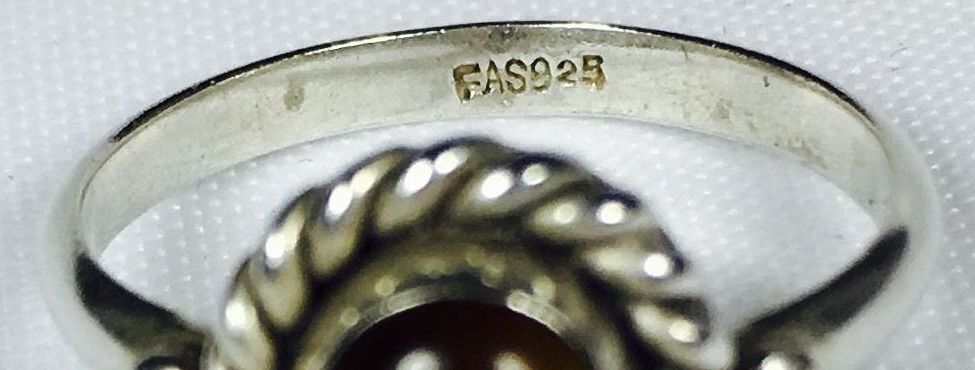
The mark FAS is not for 'Fused Alloy Silver'. What the FAS letters stand for and who the manufacturer actually is was brought up during a jewelry discussion relating to an item in question. An online article was pointed to stating that FAS was identified as Fused Alloy Silver by a Chinese seller when the author questioned them that is what they were told. There is also confusion as you continue your internet search with the mark being for the 'Fantastic Antique Silver Company' to add to the mix.
Its very easy on the internet for a blog posting to be picked up and followed by all who are also seeking information. Soon these high ranking posts have everyone following that lead, copying it over in their listings which is now making it appear to be a 'fact'. To the point that you will see that many items marked with FAS are now stated to be made by Fused Alloy Silver or the Fantastic Antique Silver Company when you do an online search but those names are incorrect.
So who really is FAS then? FAS is an international trademark for Design's by FMC :
Registered # 74203555 - FAS
Designs by FMC, Inc.
1533 60th Street
Brooklyn, New York, NY 11219 (US)
Designs by FMC line includes the manufacturing & wholesale distribution of jewelry, precious stones and costume jewelry since 1976 but this mark has only been in use since 1991. Their jewelry is manufactured overseas and imported back for sale in the US and sold by mass merchandising channels like HSN, Amazon and major department stores. In addition to sterling silver this maker also is a large producer of gold and silver plated fashion jewelry also marked FAS but without the metal fineness noted.
There is a very similar FAS trademark in the Chinese registered trademarks database without the horizontal line across the ‘A’ which may be confused with the US maker so pay close attention to how the 'A' looks on the mark.
Here is FMC's corporate website: http://www.designsbyfmc.net/
This is a Designs by FMC hang tag with the FAS trademark:
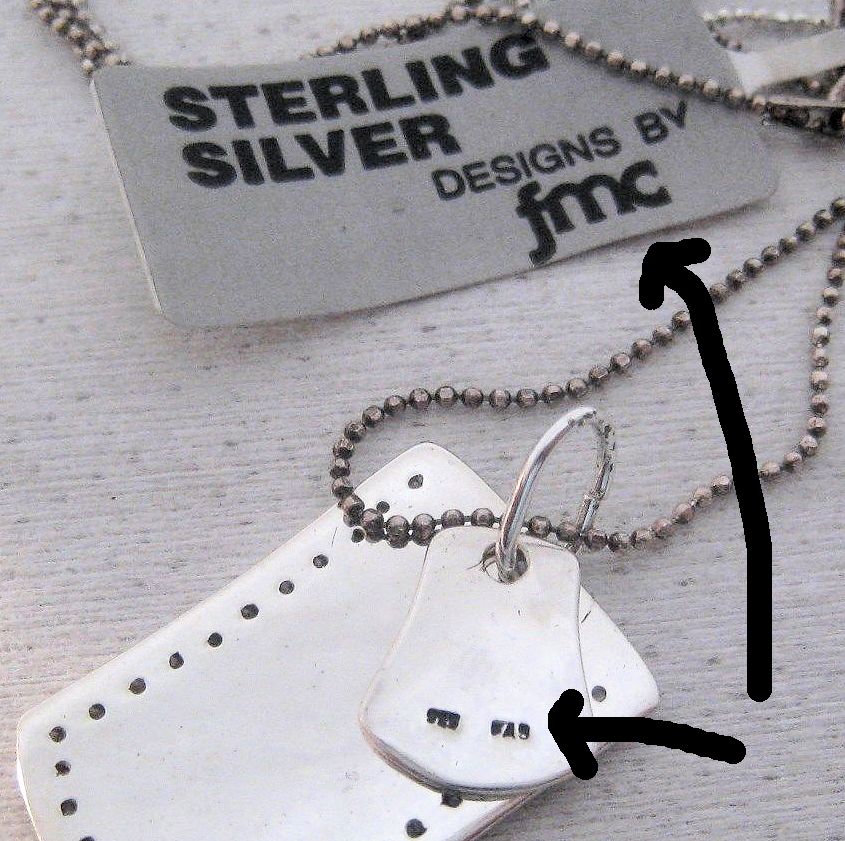
· As your researching this mark note the Kolidescope Effect at https://nasvete.com/signed-fas...has copied the information from this page with a few minor verbage changes and claimed it as theirs without crediting their source information. However when you scroll down their page's jewelry examples with the FAS mark they state some of the items are 1970's. A sign they did not do their own homework on this mark because even though Designs by FMC existed since 1973, they missed that FMC did not put the FAS mark into use until 20 years later at the end of 1991. FMC's filing on the registration of the FAS mark was not until Sept 16, 1991. In their filing it is noted the mark was first used in commerce one month later on Oct 16,1991. So any jewelry with the FAS mark is no older than late 1991 and more likely made from 1992 to present as they are still in business. I'm sure they will update their page with this though when they copy the new edits made here. They might even add a credit too this time ... ; )
Is it Opaline, Opalescent Glass or Opalite?
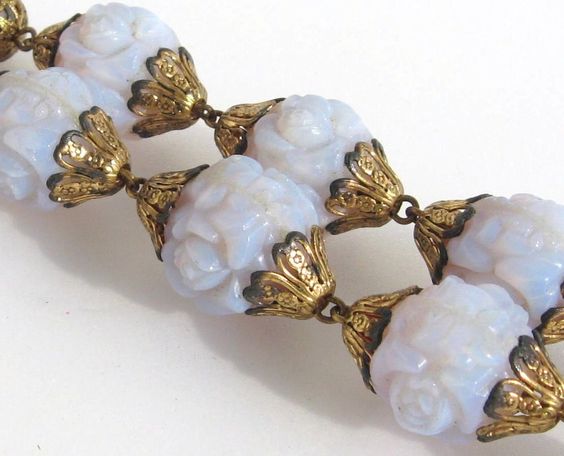
Opaline, or opal glass, was made in white, green, and other colors. The glass had a matte surface and a lack of transparency. It was often gilded or painted. It was a popular mid-nineteenth-century European glassware. Turquoise blue, yellow, and pink were the earliest colors used on opaline glass, but more vivid colors were used later to imitate the popular Bohemian glass. I've been dealing with jewelry so long that it sometimes takes me awhile to catch on to new trends and changes that creep up and take hold. With easy access to so much information all at our finger tips, we tend to get lazy or maybe just too trusting on what we read. We look for a fast answer to our questions and we tend to take first authoritative sounding source and stop there or maybe cross check a couple other listings just to be sure. If they all say the same thing we figure its safe to say they are correct, right? Well I remember way back before 'the internet' when information was not so easily found we had flip through reference books and manufacturer catalogs to identify our glass items as to what their correct trade name was. This trade name is the name a manufacturer gave to their product. This unique identifier is the name both the trade and consumers use to describe that item. When you hear this unique name you know exactly what it is and what it will look like because you recognize the name.
The reason I bring this up is a recent post of someone asking what kind of milky translucent glass beads they had. Multiple people unanimously responded opaline. At first I thought that sounds right but then the more I thought about it, I don't ever recall these glass beads being called that 30 years ago. I thought maybe things changed and the manufacturers are marketing this opal looking glass as opaline now. So I did what everyone does now, I just Googled opaline glass beads. Well big mistake, that did not offer much help. It seemed everyone was calling this opal looking glass opaline too, so no help there. Still not convinced a change was actually made but more likely a case of everyone just copying from the information they were provided in their search, I went back to to the dark ages...... I pulled out my old guides and ID books. Yes paper and hard cover books still exist in the dusty dark corners of our rooms. My 10 year old edition of Kovels had a section on glass identification clarified and made me realize that I did not miss a change in how the glass was named over the years.
Here is the difference and how to tell which kind of opalescent glass you have:
 | Opaline, or opal glass, was made in white, green, and other colors. The glass had a matte surface and a lack of transparency. It was often gilded or painted. It was popular in mid-nineteenth-century European glassware. Turquoise blue, yellow, and pink were the earliest colors used on opaline glass, but more vivid colors were used later to imitate the popular Bohemian glass. The key identifier of opaline is it is opaque. You can not see through it and it is a colorful glass. |
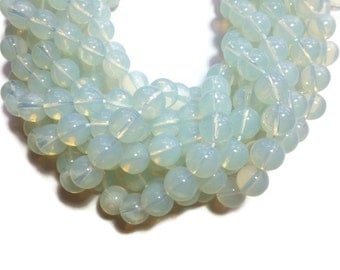 | Opalescent glass is translucent glass that has the tones of an opal gemstone. It originated in England in the 1870s and is often found in pressed glassware made in Victorian times. Opalescent glass was first made in America in 1897 at the Northwood glassworks in Indiana, Pennsylvania. Some dealers use the terms opaline and opalescent for any of these translucent wares. Opalescent glass was named for the opal gemstone. The key identifier of opalescent glass is it is translucent and you can either see through it or see light enter the bead. It looks milky with a glow to the body of the bead just like opal can. |
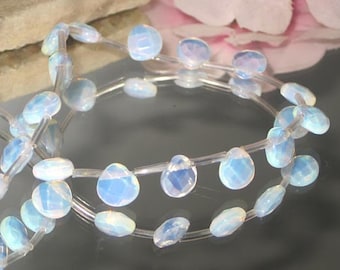 | Opalite is a man-made opalized glass resin that is fused with metal to create an opalescent effect. It is also used to promote impure varieties of variously colored common opal. Inside of opalite there appears to be a rainbow. You can read through Opalite, because it is translucent. The key identifier of opalite is it is a bright opalescent effect. It has a strong blue play of color unlike the more subdued opalescent glass. This blue coloration is more noticeable when viewed over a dark background. |
